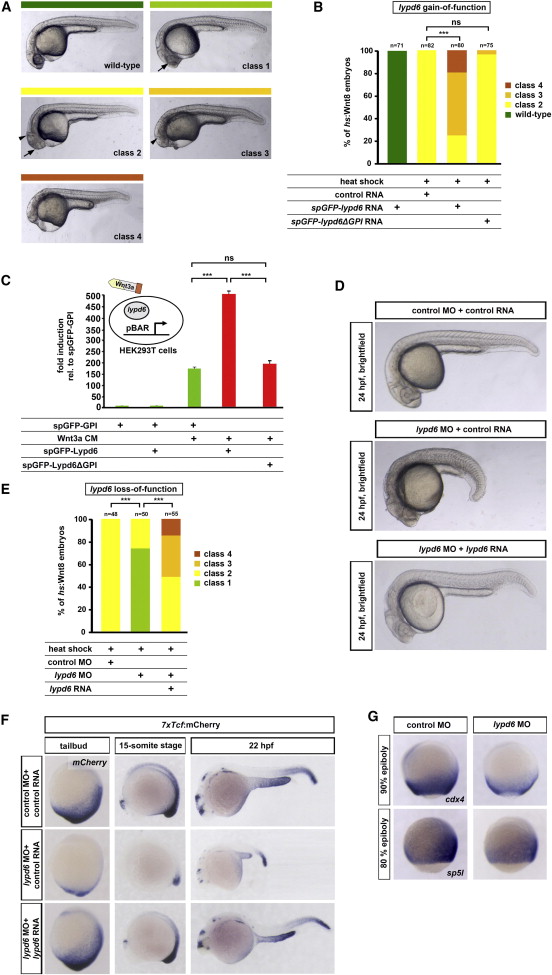Fig. 2
lypd6 Enhances Wnt/β-Catenin Signaling
(A) Classification of phenotypes caused by wnt8 overexpression in zebrafish embryos: class 1, small eyes (arrow); class 2, no eyes (arrow) but normal midbrain-hindbrain boundary (mhb) (arrowhead); class 3, severely reduced forebrain and midbrain and mhb not detectable (arrowhead); and class 4, loss of notochord.
(B) Phenotypes in hs:Wnt8 transgenic embryos injected with spGFP-lypd6 RNA (150 pg), spGFP-lypd6ΔGPI (140 pg), or equimolar amounts of spGFP-GPI control RNA and heat shocked at shield stage and scored at 24 hpf.
(C) pBAR luciferase reporter activity normalized to renilla luciferase levels in Wnt3a CM-treated HEK293T cells transfected with spGFP-Lypd6 (100 ng), spGFP-Lypd6ΔGPI (95 ng), or equimolar amounts of spGFP-GPI control. Error bars, SEM.
(D) Morphological phenotypes at 24 hpf of embryos injected with lypd6 MO (10 ng, 42/51 embryos) are rescued by coinjected lypd6 RNA (150 pg, 49/58 embryos).
(E) Rescue of phenotypes in hs:Wnt8 embryos injected with lypd6 MO (10 ng). Coinjected lypd6 RNA (150 pg) restores the more severe phenotypes.
(F) Reduction of reporter activity in 7xTcf:mCherry embryos injected with 10 ng lypd6 MO plus 100 ng control RNA (n = 28/31). Coinjected lypd6 RNA (75 ng) restores expression (n = 21/25).
(G) Downregulation of cdx4 (90% epiboly, 19/20) and sp5l (80% epiboly, 13/15) in embryos injected with 10 ng lypd6 MO.
See also Figure S2.
Reprinted from Developmental Cell, 26(4), Özhan, G., Sezgin, E., Wehner, D., Pfister, A.S., Kühl, S.J., Kagermeier-Schenk, B., Kühl, M., Schwille, P., and Weidinger, G., Lypd6 Enhances Wnt/beta-Catenin Signaling by Promoting Lrp6 Phosphorylation in Raft Plasma Membrane Domains, 331-345, Copyright (2013) with permission from Elsevier. Full text @ Dev. Cell

